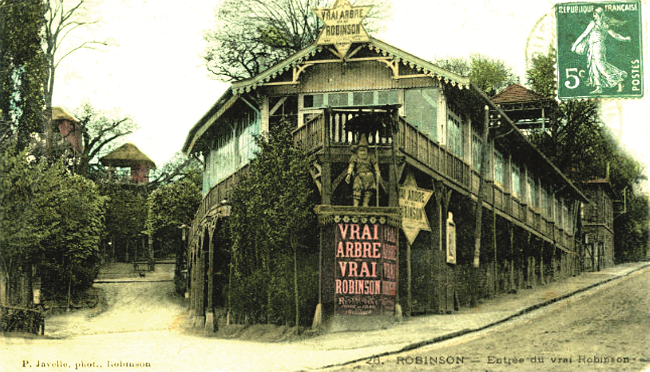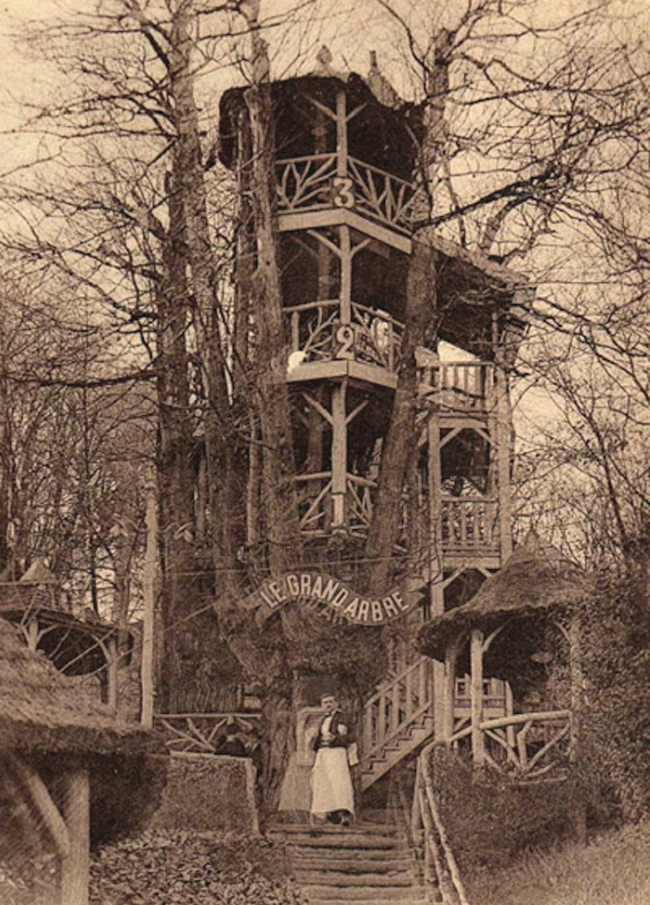Did you Know? The Treehouse Pubs of Paris


Have you heard of the treehouse ginguettes that put a Paris suburb on the map?
Situated on the southwestern edge of Paris is Robinson, the second last stop of the RER B. The origins of the surrounding village with its curiously English name starts in 1848 with Joseph Guesquin, an innkeeper in Paris, who found a stand of huge chestnut trees near the village of Le Plessis-Piquet. Inspired by the adventure stories of Swiss Family Robinson and Robinson Crusoe, Guesquin envisioned a restaurant in the trees’ leafy canopy, where wooden cabins could be linked by staircases and ramps.

© plessis-robinson website
A NEW LEAF
With the advent of the railway, Parisians could readily escape the confines of the city to the al fresco guinguettes of the suburbs. Most commonly found beside the country’s waterways, these hostelries offered food, drink and lively music. However, Guesquin built his dream guinguette in a grove of trees, constructing three shady, rose-festooned pavilions in the branches of a 200-year-old chestnut in the rue de Malabry. In these treehouses, the customers were able to enjoy a romantic meal of roast chicken and champagne, hoisted aloft by means of ropes and pulleys.
Guesquin first named the restaurant The Grand Robinson. However, his idea was so successful he soon had to rename it the Vrai Arbre de Robinson (True Tree of Robinson) because competitors found other giant chestnuts in which to build their bistros. At its height, there were more than ten taverns with more than 200 gazebos in the trees of Plessis.
Begrudging donkeys brought merry-makers from the station, and miniature train tracks reached up into the treetop canopies where customers could dine. There was wine and song as people danced to the tunes of musicians in the shady bowers below; young women on swings practised their best Fragonard poses.
The village became such a popular Sunday destination that in 1909, the district was officially renamed Plessis-Robinson. Among the glitterati that dined there were Russia’s Tsar and the Grand Duke Constantine, as well as Spain’s Queen Isabella and King Alfonso XIII.

© grandeabre
Fading fortunes
As the spirit of the French guinguette faded, the Robinson treehouse taverns gave way to homes with rather more solid footings.
Then, in 1966, another investor with his head in the clouds breathed fresh life into the old pavilions. French pop sensation Johnny Hallyday bought the Vrai Arbre Robinson and renovated it into a Wild-West dream named Robinson Village. With horses, a rifle range and a saloon, it replicated an American-style ranch. At its disco, the Tchoo-Tchoo Club, Halliday introduced the then-unknown guitar player Jimi Hendrix. But despite its cachet, Robinson Village became a commercial failure.
The last of the tree-top bars, Le Grand Arbre, closed for good in 1976 and the remaining relics, located to the southwest of Parc Henri Sellier, have since been redeveloped.
From France Today Magazine
Lead photo credit : © Wikimedia Commons
Share to: Facebook Twitter LinkedIn Email
More in bars, French history, guinguettes, Paris
By Hazel Smith
Leave a reply
Your email address will not be published. Required fields are marked *




REPLY